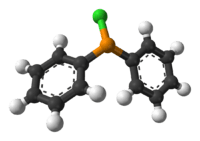Chlorodiphenylphosphine
 | |
 | |
| Names | |
|---|---|
| Preferred IUPAC name
Diphenylphosphinous chloride | |
| Other names
chlorodiphenylphosphine p-chlorodiphenylphosphine diphenyl phosphine chloride diphenylchlorophosphine | |
| Identifiers | |
| 1079-66-9 | |
| 3D model (Jmol) | Interactive image |
| ChemSpider | 59567 |
| ECHA InfoCard | 100.012.813 |
| UNII | WO975PJK1Y |
| |
| |
| Properties | |
| C12H10ClP | |
| Molar mass | 220.63776 g mol−1 |
| Appearance | clear to light yellow liquid |
| Density | 1.229 g cm−3 |
| Boiling point | 320 ˚C |
| Reacts | |
| Except where otherwise noted, data are given for materials in their standard state (at 25 °C [77 °F], 100 kPa). | |
| | |
| Infobox references | |
Chlorodiphenylphosphine is an organophosphorus compound with the formula (C6H5)2PCl, abbreviated Ph2PCl. It is a colourless oily liquid with a pungent odor that is often described as being garlic-like and detectable even in the ppb range. It is useful reagent for introducing the Ph2P group into molecules, which includes many ligands.[1] Like other halophosphines, Ph2PCl is reactive with many nucleophiles such as water and easily oxidized even by air.
Synthesis and reactions
Chlorodiphenylphosphine is produced on a commercial scale from benzene and phosphorus trichloride (PCl3). Benzene reacts with phosphorus trichloride at extreme temperatures around 600 °C to give dichlorophenylphosphine (PhPCl2). Redistribution of PhPCl2 in the gas phase at high temperatures results in chlorodiphenylphosphine.[1][2]
- 2 PhPCl2 → Ph2PCl + PCl3
Alternatively such compounds are prepared by redistribution reactions starting with triphenylphosphine and phosphorus trichloride. Synthesis of Ph2PCl by the direct reaction of phenylmagnesium bromide and phosphorus trichloride is not practiced. On the other hand, PCl3 can be usefully converted to its monoamide, which in turn undergoes alkylation or arylation. Subsequent removal of the amide gives :[3]
- PCl3 + 2 (iPr)2NH → (iPr)2NH2Cl + (iPr)2NPCl2
- (iPr)2NPCl2 + 2 PhMgBr → (iPr)2NPPh2 + 2 MgBrCl
- (iPr)2NPPh2 + 2 HCl → (iPr)2NH2Cl + PPh2Cl
Unlike the synthesis of chlorodiisopropylphosphine, reaction of two equivalents of the phenyl Grignard reagents with PCl3 does not efficiently afford the monochloride.
Chlorodiphenylphosphine hydrolyzes to give diphenylphosphine oxide. With amines, it forms the amides Ph2PNR2.
Uses
Ph2PCl, along with other chlorophosphines, is used in the synthesis of various phosphines. A typical route uses Grignard reagents:[2]
- Ph2PCl + MgRX → Ph2PR + MgClX
The phosphines produced from reactions with Ph2PCl are further developed and used as pesticides (such as EPN), stabilizers for plastics (Sandostab P-EPQ), various halogen compound catalysts, flame retardants (cyclic phosphinocarboxylic anhydride), as well as UV-hardening paint systems (used in dental materials) making Ph2PCl an important intermediate in the industrial world.[1][2]
Precursor to diphenylphosphido derivatives
Chlorodiphenylphosphine is used in the synthesis of sodium diphenylphosphide via its reaction with sodium metal in refluxing dioxane.[4]
- Ph2PCl + 2 Na → Ph2PNa + NaCl
Diphenylphosphine can be synthesized in the reaction of Ph2PCl and LiAlH4, the latter usually used in excess.[5]
- 4 Ph2PCl + LiAlH4 → 4 Ph2PH + LiCl + AlCl3
Both Ph2PNa and Ph2PH are also used in the synthesis of organophosphine ligands.
Characterization
The quality of chlorodiphenylphosphine is often checked by 31P NMR spectroscopy.[6]
| Compound | 31P chemical shift
(ppm vs 85% H3PO4) |
|---|---|
| PPh3 | -6 |
| PPh2Cl | 81.5 |
| PPhCl2 | 165 |
| PCl3 | 218 |
References
- 1 2 3 Quin, L. D. A Guide to Organophosphorus Chemistry; Wiley IEEE: New York, 2000; pp 44-69. ISBN 0-471-31824-8
- 1 2 3 Svara, J.; Weferling, N.; Hofmann, T. "Phosphorus Compounds, Organic," In 'Ullmann's Encyclopedia of Industrial Chemistry, 7th ed.; Wiley-VCH: 2008; doi:10.1002/14356007.a19_545.pub2; Accessed: February 18, 2008.
- ↑ A. Bollmann, K. Blann, J. T. Dixon, F. M. Hess, E. Killian, H. Maumela, D. S. McGuinness, D. H. Morgan, A. Neveling, S. Otto, M. Overett, A. M. Z. Slawin, P. Wasserscheid, S. Kuhlmann, "Ethylene Tetramerization: A New Route to Produce 1-Octene in Exceptionally High Selectivities" J. Am. Chem. Soc 2004, 126, 14712-14713 plus supporting information. doi: 10.1021/ja045602n
- ↑ Roy, Jackson W; Thomson, RJ; MacKay.m.f, . (1985). "The Stereochemistry of Organometallic Compounds. XXV. The Stereochemistry of Displacements of Secondary Methanesulfonate and p-Toluene-sulfonate esters by Diphenylphosphide Ions. X-ray Crystal Structure of (5α-Cholestan-3α-yl)diphenylphosphine Oxide". Australian Journal of Chemistry. 38 (1): 111–18. doi:10.1071/CH9850111.
- ↑ Stepanova, Valeria A.; Dunina, Valery V.; Smoliakova, Irina P. (2009). "Reactions of Cyclopalladated Complexes with Lithium Diphenylphosphide". Organometallics. 28 (22): 6546–6558. doi:10.1021/om9005615.
- ↑ O. Kühl "Phosphorus-31 NMR Spectroscopy" Springer, Berlin, 2008. ISBN 978-3-540-79118-8